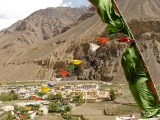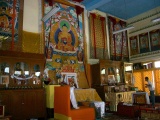Tabo Monastery
Tabo Monastery (or Tabo Chos-Khor Monastery) was founded in 996 CE in the Spiti Valley, Himachel Pradesh, India by the great Tibetan Buddhist lotswa (translator), Rinchen Zangpo, the king of western Himalayan Kingdom of Guge. It is located in the very arid, cold and rocky area at an altitude of 3,050 metres (10,007 ft).
The monastery is surrounded by a high mud brick wall which encloses some 6,300 square metres. (over 1½ acres) and contains 9 temples, 23 chortens, a monks' residence and an extension that houses the nuns' residence. It soon became known as an important centre of learning and of the Kadampa School (which later developed into the Gelugpa School). However, in 1855 it was reported to have had only 32 monks.
After the earthquake of 1975 a new monastery was built, and in 1983 a new Du-kang or Assembly Hall was constructed. It here that H.H. the Dalai Lama held the Kalachakra ceremonies in 1983 and 1996. Above the monastery there are a number of caves carved into the cliff face and used by monks for meditation.
There is a large and priceless collection of thankas (scroll paintings), manuscripts, well-preserved statues, frescos and extensive murals which cover almost every wall.
The monastery includes nine temples:
1. The Temple of the Enlightened Gods (gTug-Lha-khang), or Assembly Hall.
2. The Golden Temple (gSer-khang). Said to have been once covered with gold, it was renovated by Sengge Namgyal, a king of Ladakh in the 16th century. The walls and ceilings are covered with magnificent murals.
3. The Initiation Temple (dKyil-kHor- khang). There is a huge painting of Vairocana surrounded by eight Bodhisattvas. The other walls are covered in mandalas. This is where monks receive their initiations.
4. The Bodhisattva Maitreya Temple (Byams-Pa Chen-po Lha-khang). The image of the Bodhisattva Maitreya here is over six meters (20 feet) high. There are also murals showing Tashilhunpo Monastery in Shigatse and the Potala in Lhasa.
5. The Temple of Dromton (Brom-ston Lha khang) which is thought to have been founded by Dromton (1008-1064 CE) one of the main disciples of Atisha.
The above are thought to be the earliest temples of Tabo and the following are later additions.
6. The Chamber of Picture Treasures (Z'al-ma).
7. The Large Temple of Dromton (Brom-ston Lha khang). After the Assembly Hall, this is the largest temple in the complex and contains many wall paintings. The wooden planks in the ceiling are also decorated.
8. The Mahakala Vajra Bhairava Temple (Gon-khang) contains the protective deity of the Gelukpa sect. It contains fierce deities and is only entered after protective meditation.
9. The White Temple (dKar-abyum Lha-Khang).
Tabo Monastery is protected by the Archaeological Survey of India as a national historic treasure of India.




